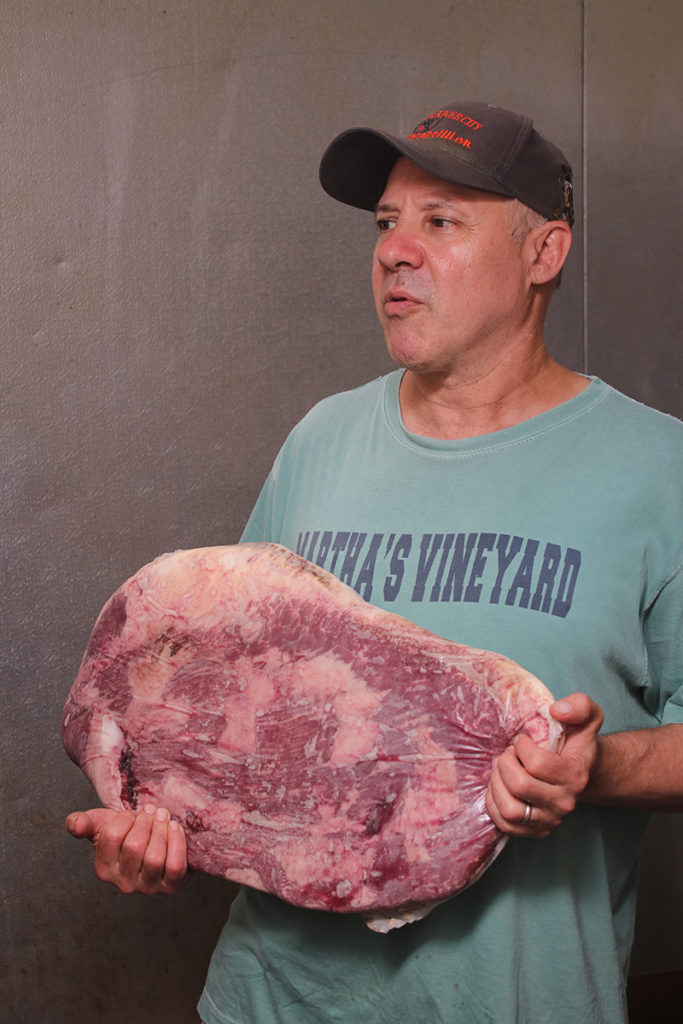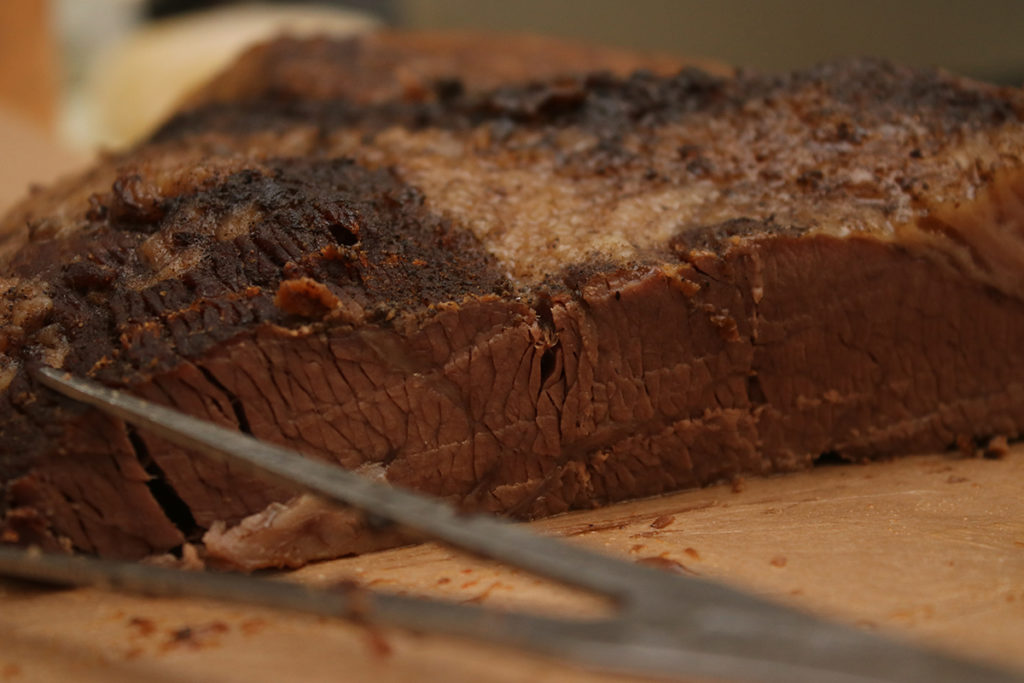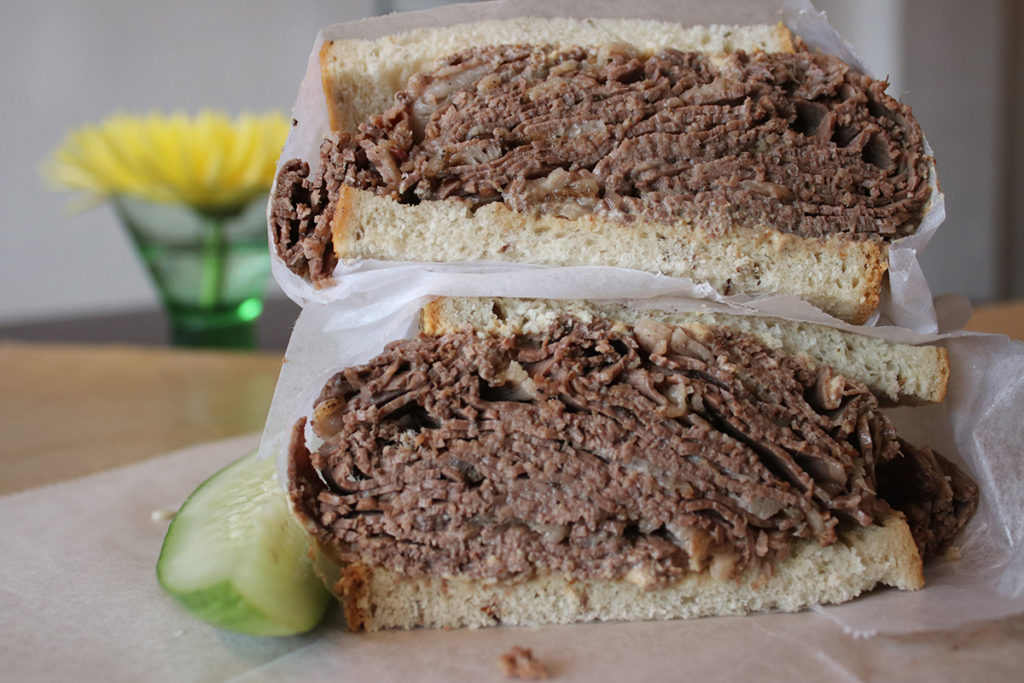Beginner’s brisket
Story by Jane Kaufman | Photography by Michael C. Butz
As autumn arrives, there may not be a more evocative aroma than the blend of sweet, tangy and savory that emanates from a slow-roasted brisket.
For a certain generation of American Jews, nothing may call to mind Erev Rosh Hashanah more than a kitchen and home filled with the complex and distinctive scent centered around that particular cut of beef.
Cooked perfectly, a brisket can be cooled, and under the weight of a meat slicer, can be shaved for a succulent sandwich or sliced by hand in generous slabs for a filling entrée.
Preparing brisket well is not particularly demanding nor does it require sustained effort, but it does require patience and attention to all aspects of the process.
Choosing the cut
First, a primer on cuts of brisket. A whole brisket contains just two parts but several names.
There is the flat section, a relatively geometric cut of beef that is nearly rectangular and fairly lean with a fatty layer on top. One of its features is a consistent grain. The flat is often referred to as a first cut.
The point is a fattier, rounder, somewhat irregularly shaped triangular mass of beef that is attached to the neater flat. It is sometimes called a second cut.
Hank Kornblut, proprietor of Mister Brisket, which has been a community staple in University Heights for decades, says it used to be that Jewish women preparing for High Holy Days knew exactly what cut of beef they wanted for a slow-roasted brisket in a speckled enamel roasting pan.
“Forty years ago, all the Jewish women for holidays would order the full brisket,” he says. “They’d order it, you know, a month in advance, and they would cook it. They’d bring it back in and we’d slice it for them and they’d freeze it.
“Then, everyone became afraid of fat,” Kornblut remembers, and the orders for first cut brisket started coming in. “It’s easier to cook and it’s easier to slice.”

Today, Kornblut is hearing from people who intend to slow roast brisket in the same manner as their mothers and grandmothers, but they’re requesting a different cut of beef.
“What’s happening now is there’s so much new information out there that sometimes people are asking me for a second cut, which is just the point, but that’s really a fatty cut to cook for your family,” he says. “You really don’t want that because it’s primarily used to make something called burnt ends, which is, you know, something you make when you’re smoking brisket.
“So, I have to spend time now explaining to people that they don’t want a second cut even though they’ve heard it’s really good,” he says. “What they still want is a first cut, but they just want to make sure there’s some fat on it.”
Why keep the fat?
“A lot of people will go to the supermarket and buy brisket and complain to me how dry their brisket was because it had all the fat trimmed off it,” he says. “When I do a first cut, I leave fat on it.”
So, in the case of brisket, it turns out Mom (or Bubbe) really does know best.
“Or they want to cook a whole brisket, with both sections intact,” he says. “In this day and age, I spend a lot of time trying to identify which type of brisket they want to cook.”

Time and temperature
Starting with the right cut of beef trimmed appropriately will go a long way toward assuring great results from a traditionally slow roasted brisket.
“The single most important thing is that no matter how you cook your brisket, no matter what recipe you follow, you still want to cook to what is called ‘fork tender,’” Kornblut says. “That means when you put a fork in there – or a toothpick or whatever device you got – it should be really soft. And when you pull it out, there should be virtually no resistance.”
Kornblut’s advice on cooking temperature and time is 325 degrees for three-and-a-half hours and checking the internal temperature of the meat with a thermometer.
The internal temperature needed to achieve fork tenderness will depend on the type of brisket. Typical American beef – whether USDA prime, choice or select – will generally need to reach an internal temperature of 200 to 205 degrees, Kornblut says. American Wagyu beef, popular in barbecue because of its marbling, will need to reach 210 to 215 degrees. Wagyu are cattle whose roots can be traced to Japan.
“But fork tenderness is always your ambition when you’re cooking a brisket,” Kornblut says. “So, no matter how you’re cooking it – whether you’re smoking it, whether you’re Instapotting, whether you’re Crockpotting, whether you’re roasting in your old-fashioned speckled roasting pan – you still need to know the temperature, and then you still need to make sure it’s fork tender.”
The cooking time will not depend on weight.
“The biggest factor in determining how long you have to cook your brisket is the thickness,” Kornblut says. “The thicker it is, the longer it takes.”

Selecting the seasoning
There are, of course, dozens of ways to flavor brisket before it undergoes cooking.
Mister Brisket’s famous recipe, which owner Sanford Herskovitz developed, includes a mix of sweet and savory flavors derived from just three ingredients: two cans of RC Cola (or any brand of non-diet cola), one bottle of Heinz chili sauce and an envelope of Lipton’s onion soup mix. Mix them together, pour over the top of a 6-pound raw first cut, fat side up, and pop into the oven in a covered roaster at 325 degrees.
It’s possible, Kornblut says, to make a simple and savory pot roast with beef stock, onion, garlic, salt and pepper. Fruit and beef pair well, and that pairing might be particularly appropriate for Rosh Hashanah, when sweetness figures as a prominent theme.
In fact, Kornblut says he recently took a call from a man competing in a barbecue contest who was worried because he had injected the wrong blend into his brisket. It was a mix of pineapple and apple juices.
“I’ve smoked brisket, and I used applewood, and I thought it was much better than when I used a non-fruit wood, like mesquite,” Kornblut says. “I told him, ‘Brisket loves sweet. So this might work out fine, just wait and see.’ And he goes, ‘Well, I’m sure the judges are going to think it’s interesting.’ The bottom line is, he came in first (place) out of 50.”

